Eremophila dempsteri facts for kids
Quick facts for kids Eremophila dempsteri |
|
|---|---|
 |
|
| Eremophila dempsteri leaves and flowers | |
| Scientific classification | |
| Genus: |
Eremophila (plant)
|
| Species: |
dempsteri
|
| Synonyms | |
|
|
Eremophila dempsteri is a beautiful flowering plant. It belongs to the figwort family, called Scrophulariaceae. This plant grows only in the southern part of Western Australia. This means it is endemic to that area.
It is a tall shrub with many straight stems. It has short, curved leaves and pretty pinkish-purple to white flowers. The flowers have special woolly parts called sepals.
Contents
About Eremophila dempsteri
Eremophila dempsteri is a shrub that stands upright. It can grow between 1 and 4 meters (about 3 to 13 feet) tall. It has many straight branches, which make it look a bit like a broom.
The branches have many small, raised bumps called resin glands. These glands make the branch tips feel sticky. There are also grooves under where the leaves attach.
Leaves of the Plant
The leaves grow one after another along the branches. They are dark green and usually 2 to 7.5 millimeters (about 0.08 to 0.3 inches) long. They are also very thin, about 0.5 to 1.3 millimeters (0.02 to 0.05 inches) wide. Each leaf has a curved, hooked tip.
Flowers and Fruits
The flowers grow either alone or in pairs where the leaves meet the stem. They sit on small stalks that are 2 to 4 millimeters (about 0.08 to 0.16 inches) long. These stalks can also be sticky or scaly from the resin.
Each flower has 5 sepals, which are like small leaves that protect the bud. They are slightly oblong or spear-shaped and are hairy inside and along their edges. These sepals are 4 to 6.5 millimeters (about 0.16 to 0.26 inches) long.
The petals are 9.5 to 13 millimeters (about 0.37 to 0.51 inches) long. They join together at the bottom to form a tube shape. This petal tube is usually a soft lilac color or white and does not have spots. The outside of the petal tube and the petal lobes (the top parts of the petals) are hairy.
Inside the petal tube are 4 stamens, which are the parts that produce pollen. These stamens are completely hidden inside the tube. The plant usually flowers from July to October. After flowering, it produces oval-shaped, hairy fruits that are 3 to 5 millimeters (about 0.12 to 0.2 inches) long.

Plant Naming and History
This plant, Eremophila dempsteri, was first officially described in 1876. It was named by a scientist named Ferdinand von Mueller. His description was published in a book called Fragmenta phytographiae Australiae.
The second part of the plant's name, dempsteri, honors Andrew Dempster. He was an explorer and collected the very first sample of this plant that scientists used to describe it. Andrew was the son of a politician, Charles Dempster.
Where Eremophila dempsteri Grows
This type of eremophila plant is common in several areas of Western Australia. You can find it between Balladonia, Coolgardie, Hyden, Cocklebiddy, and Salmon Gums.
It usually grows in woodlands. The soil it prefers is red-brown and contains calcium carbonate, which is a type of lime.
Conservation Status
The Government of Western Australia's Department of Parks and Wildlife says that Eremophila dempsteri is "not threatened." This means it is not currently in danger of disappearing.
Growing Eremophila dempsteri in Gardens
This eremophila plant has unique flowers and a nice shape. This makes it a great choice for a special plant in a garden. Because of how it grows, it can also be used with other shrubs to create a screen or hedge.
You can grow new plants from cuttings. Sometimes it takes a year for these cuttings to start growing roots. Another way is by grafting it onto other Myoporum species.
This plant can grow well in most types of soil. It likes full sun or partial shade. It can handle dry periods (is tolerant of drought) and is not harmed by very cold temperatures (severe frosts).

